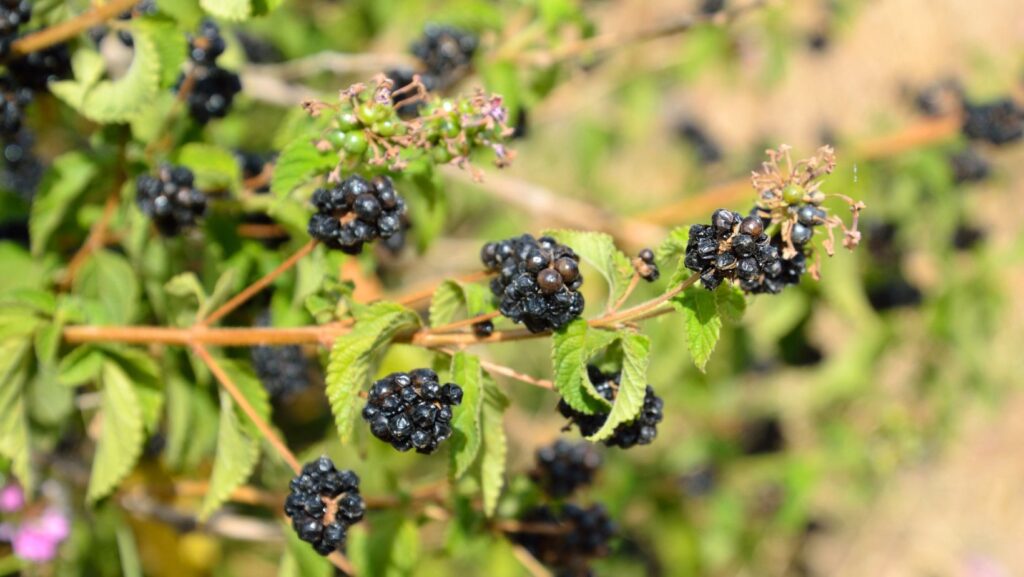Blackberry bushes are among the most rewarding plants you can grow in a home garden. They deliver fresh, sweet fruit through summer and often thrive with less maintenance than other berries.
However, like all perennials, they need the right combination of water, pruning, and seasonal care to stay productive year after year.
This guide explains the basics of blackberry bush care, including planting, feeding, pruning, and harvesting tips to help you enjoy a healthy, abundant crop. Your first step is to purchase from a reliable nursery; our guide covers everything after that!
Blackberry Bush Care Tip #1: When and Where to Plant
Blackberry bushes grow best in sunny spots with rich, well-drained soil. Look for a location that gets at least six to eight hours of direct sunlight each day. Good airflow is also essential, as it helps reduce the risk of fungal diseases.
Choosing the right site and preparing the soil carefully will give your blackberry bushes the strongest possible start. With good spacing and ample sunlight, your plants will grow quickly and remain productive for years. Taking the time to set up these basics makes every step of blackberry bush care easier in the long run.
Blackberry Bush Care Tip #2: Watering and Feeding Your Plant
Consistent moisture is essential for good berry production. During the first growing season, water young plants deeply every week, soaking the root zone to encourage strong development. At the same time, mulch around the base of your plants with straw or shredded bark. It helps retain moisture, suppress weeds, and regulate soil temperature.
Additionally, arrange for fertilization in early spring with a balanced 10-10-10 fertilizer or organic compost. Avoid heavy nitrogen applications, which can produce excessive leafy growth and fewer fruits.
Blackberry Bush Care Tip #3: Pruning and Trailing
Pruning is one of the most important parts of caring for blackberry bushes. The best time to do it is in late winter or early spring, before new growth begins. You’ll want to remove any canes that are damaged, diseased, or weak, as they can harbor pests or reduce productivity.

Also, note that some trailing blackberry varieties need support to keep canes off the ground. Use a trellis or wire system to tie healthy canes horizontally. This makes harvesting easier and helps prevent disease by improving air circulation. Erect varieties usually stand on their own but still benefit from occasional tying and thinning.
Blackberry Bush Care Tip #4: Managing Pests and Diseases
Even with proper watering and pruning, blackberry bushes can face a few common problems. Regular inspections and preventive steps go a long way toward keeping your plants healthy.
According to research, blackberry bushes attract a variety of common pests, such as aphids, spider mites, and Japanese beetles. These insects suck sap, chew on leaves and shoots, and weaken growth. Ensure to check and remove them frequently to keep your plants safe.
Our tip: Inspect your plants every week during the growing season. Promptly removing damaged or diseased parts helps prevent larger outbreaks and keeps your bushes thriving.
Blackberry Bush Care Tip #5: Harvesting and Maintenance
Blackberries are typically ready for harvest in midsummer, although the exact timing varies by region and variety. You’ll know they’re ripe when the berries turn entirely black, feel slightly soft, and pull away from the stem with little resistance.
Once harvest is complete, continue watering regularly if the weather stays hot. This helps the plants recover and store energy for next year’s growth. After the first frost, remove any old or diseased canes to keep your patch clean and ready for the next season.
Blackberry Bush Care Tip #6: Mulching and Winter Protection
Mulching is a simple step that makes a big difference in the health and productivity of blackberry bushes. A thick mulch layer helps regulate soil temperature, keeps weeds down, and conserves moisture during hot weather.
There isn’t a strict guideline, but most gardeners agree that applying 2–4 inches of straw, shredded bark, or pine needles around the base of each plant is a good idea. You’ll want to keep the mulch a couple of inches away from the canes to prevent rot and refresh it each year.
If you reside in colder regions, winter protection is essential. After pruning, add an extra layer of mulch to insulate the roots and protect them from further damage.
Every Blackberry Bush Deserves the Best Care
With proper care, your blackberry bushes will reward you season after season. From planting and pruning to watering and harvesting, each step brings you closer to a thriving patch and baskets of sweet, homegrown fruit.
Get started now, and look forward to harvests you’ll be proud of.

